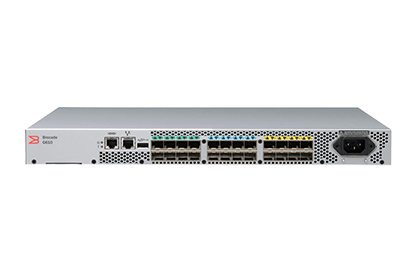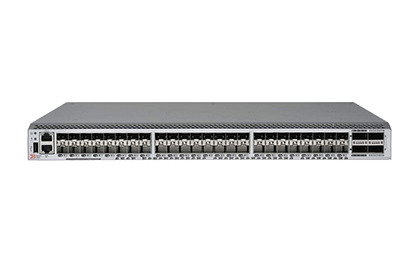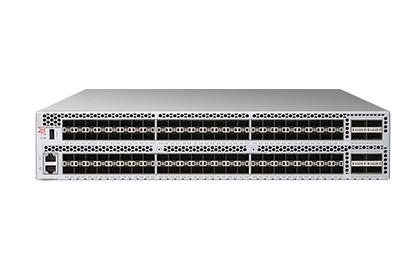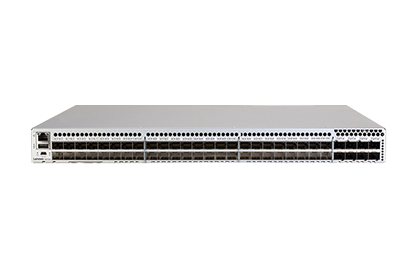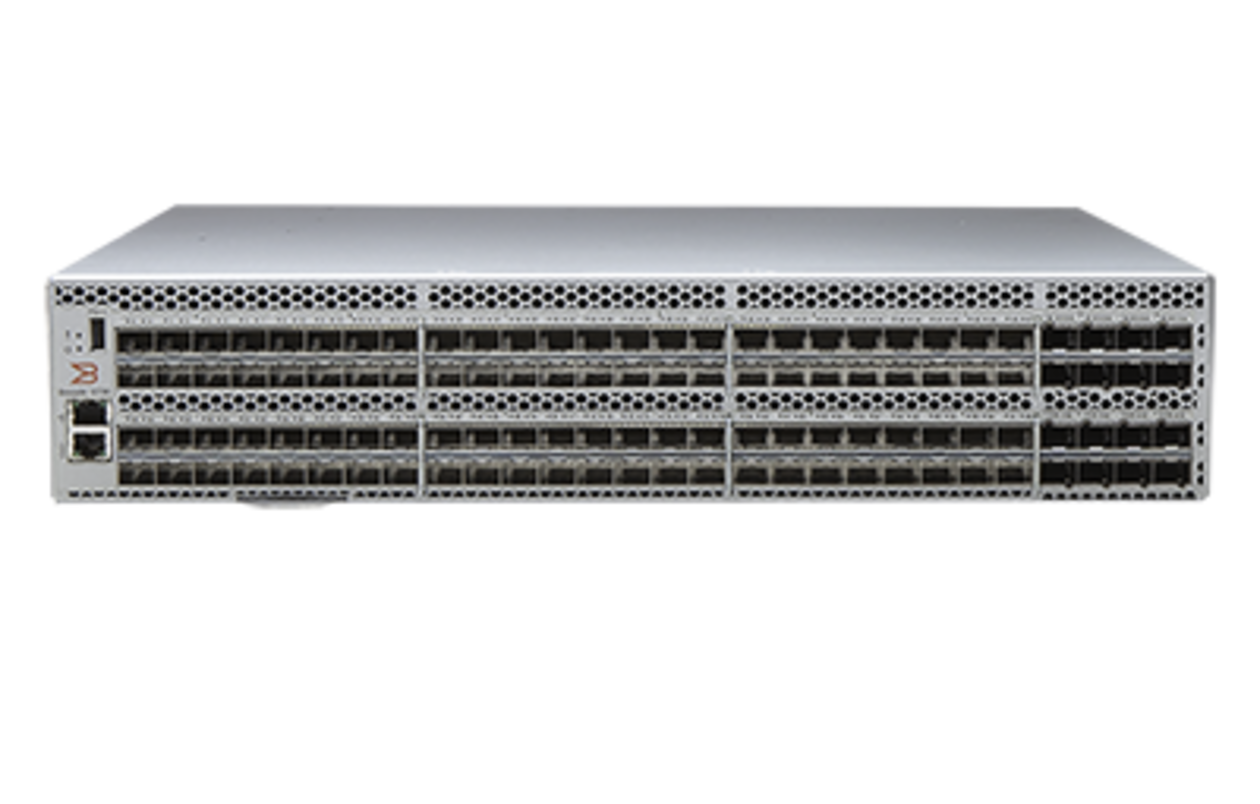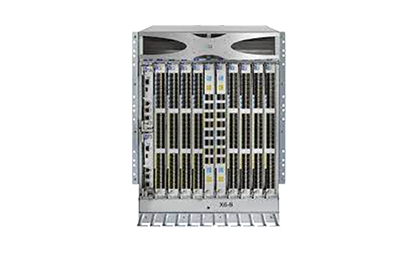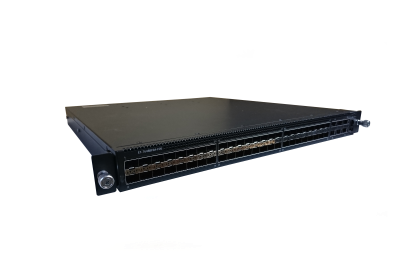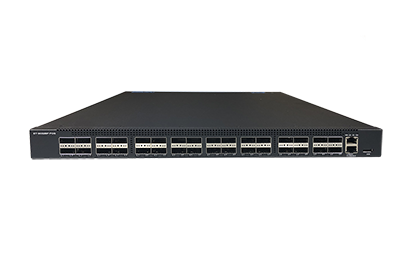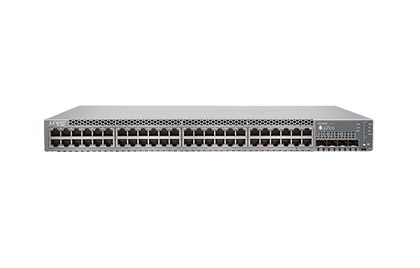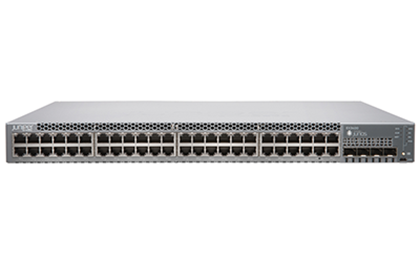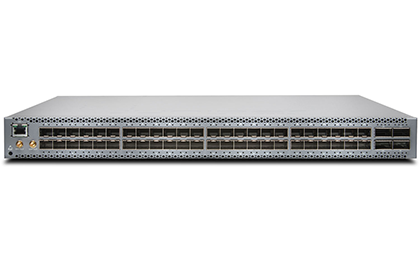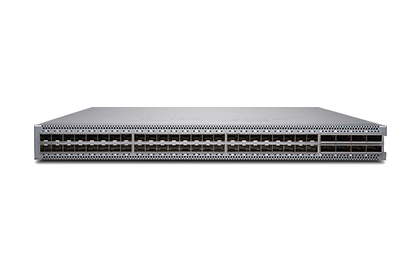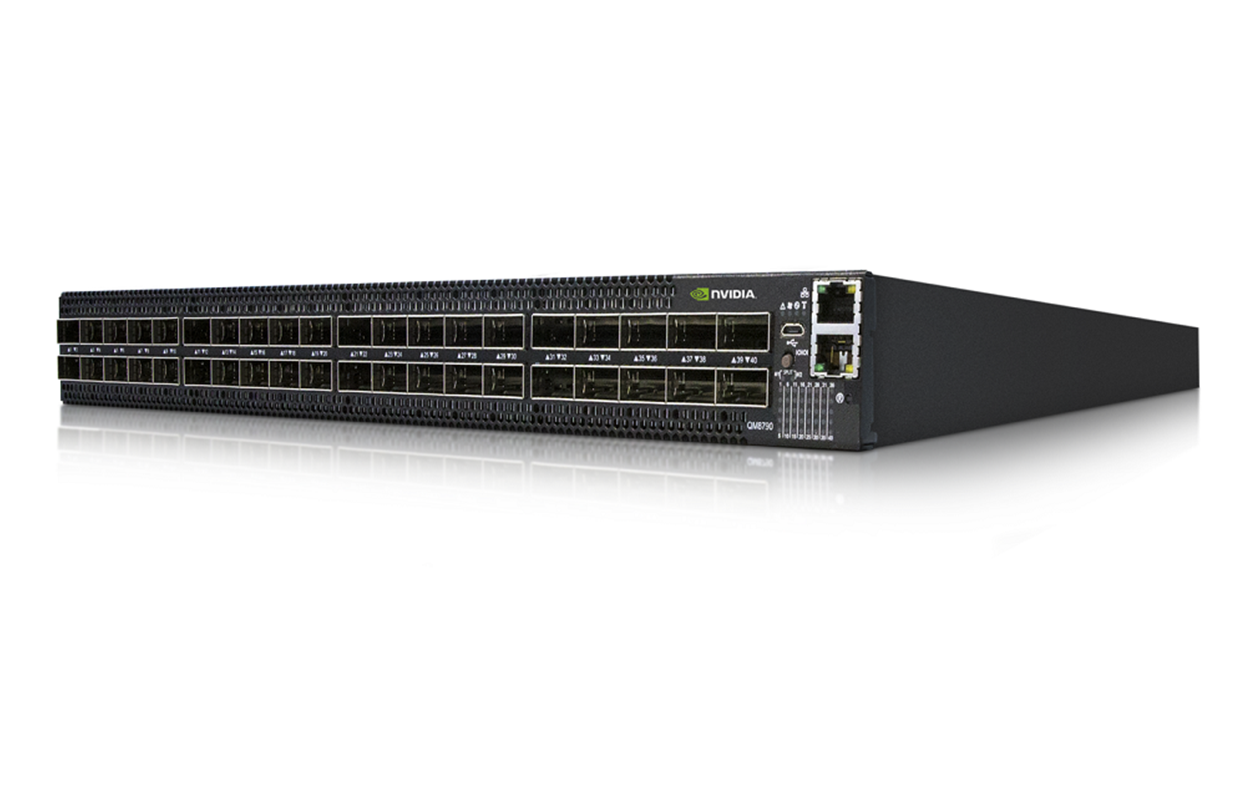For your edge-core-cloud scenarios
Networking solutions

Fujitsu has developed a suite of top-of-rack switches that support flexible and efficient scale-out server infrastructures, especially in combination with new modular servers. This approach results in several improvements, including infrastructure efficiency for cloud computing, end-to-end virtualization and consolidation. Close partnerships with network technology partners complement the portfolio for building complete IT infrastructures. Storage-area networks (SANs) will continue to be the backbone of the data center network for the next investment cycle, but they need enhancements in terms of bandwidth and management functions. To do this, Fujitsu partners with Broadcom, which recently acquired Brocade, the leading provider of SAN switches. And a lot of new use cases are based on Ethernet networks, with bandwidths of up to 100 Gbit and increasingly virtualized fabric architectures for building dynamic data centers. Fujitsu also partners with Extreme Networks, which offers the best of breed, high performance IP Networking Switches. And it goes without saying that Fujitsu server and storage systems are fully compatible with products from all important network switch vendors, including Cisco.
Transform your network with the right switches
Vendor
Product type
Network speed
Number of ports (max.)
Media type
| Brocade G610 | Brocade G620 | Brocade G630 | Brocade G720 | Brocade G730 | Brocade X7 Directors | FUJITSU PSWITCH 2048 | FUJITSU PSWITCH 4032P | Juniper EX2300 | Juniper EX3400 | Juniper QFX5110 | Juniper QFX5120 | NVIDIA InfiniBand Switch 40-port 200Gb/s | |
|---|---|---|---|---|---|---|---|---|---|---|---|---|---|
| Fibre Channel performance | Fibre Channel: 4.25 Gbps line speed, full duplex; 8.5 Gbps line speed, full duplex; 14.025 Gbps line speed, full duplex; auto-sensing of 4 Gbps, 8 Gbps, 16 Gbps, and 32 Gbps port speeds | Fibre Channel: 4.25 Gbps line speed, full duplex; 8.5 Gbps line speed, full duplex; 14.025 Gbps line speed, full duplex; 28.05 Gbps, full duplex; 112.2 Gbps, full duplex; auto-sensing of 4, 8, 16, 32 Gbps port speeds and capable of supporting 128 Gbps speeds | Fibre Channel: 4.25 Gbit/s line speed, full duplex; 8.5 Gbit/s line speed, full duplex; 10.53 Gbit/s line speed, full duplex; 14.025 Gbit/s line speed, full duplex; 28.05 Gbit/s, full duplex; 112.2 Gbit/s, full duplex; auto-sensing of 4/8/10/16/32 Gbit/s port speeds and capable of supporting 128 Gbit/s speeds; 10 Gbit/s optionally programmable to fixed port speed. Auto-sensing of 4×32 / 4×16 / 4×8 / 4×4 Gbit/s speeds on the QSFP ports with Brocade FOS v8.2.0. |
Fibre Channel: 8.5Gb/s line speed, full duplex; 10.53Gb/s line speed, full duplex; 14.025Gb/s line speed, full duplex; 28.05Gb/s line speed, full duplex; 57.8Gb/s line speed, full duplex; auto-sensing of 8, 10, 16, 32, and 64Gb/s port speeds. 10Gb/s [1] optionally programmable to fixed port speed. [1] only available in Europe, Middle East & Africa |
Fibre Channel: 8.5Gb/s line speed, full duplex; 10.53Gb/s line speed, full duplex; 14.025Gb/s line speed, full duplex; 28.05Gb/s line speed, full duplex; 57.8Gb/s line speed, full duplex; auto-sensing of 8, 10, 16, 32, and 64G port speeds. 10G[1] optionally programmable to fixed-port speed. [1] 10G is only available in Europe, Middle East & Africa |
- | - | - | - | - | - | - | - |
| Fibre Channel ports |
Switch mode (default): 8-, 16-, and 24-port configurations (8-port increment through Ports on Demand [PoD] license); E_Ports, F_Ports, M_Ports, and D_Ports Brocade Access Gateway default port mapping: 40 SFP+ F_Ports, 8 SFP+ N_Ports |
Switch mode (default): Minimum of 24 ports and maximum of 64 ports configuration. Port numbers above minimum are enabled through 12-port SFP+ increments via Ports on Demand (PoD) licenses and through one 4-port QSFP PoD, providing 16-port increments through a Q-Flex license; E_Ports, F_Ports, D_Ports,EX_Ports. Brocade Access Gateway default port mapping: 40 SFP+ F_Ports, 8 SFP+ N_Ports |
96 SFP+ ports capable of operating at 4/8/10/16/32 Gbit/s Fibre Channel auto-sensing speeds; 8 QSFP ports capable of operating at 4×32 / 4×16 / 4×8 / 4×4 Gbit/s Fibre Channel speeds. Offers a base configuration of 48 ports, two 24-port SFP+ PoD (Ports on Demand), and one 32-port QSFP PoD. The switch has a total of eight 32 Gbit/s QSPF ports. This allows users to grow from 48 ports to 128 ports. Supports F/E/EX_Port and D_Port types on the SFP+ ports and only F/E/EX_Port and D_Port types on the QSFP ports with Brocade Fabric OS® (FOS) v8.2.0. |
Switch mode (default): Minimum of 24 ports and maximum of 56 ports. Ports are enabled in increments of 8 ports up to 56 ports via Ports on Demand (PoD) licenses; E_Ports, F_Ports, M_Port, D_Ports, EX_Ports. Brocade Access Gateway default port mapping: 56 SFP+ F_Ports, 8 SFP+ N_Ports. |
128 ports (96 64G SFP+ ports, plus 16 2x64G SFP-DD ports), each supporting E_Ports, F_Ports,M_Ports, D_Ports, and EX_Ports. 48-port base configuration; additional ports are enabled with two 24-port SFP+ PODs (Ports on Demand), plus a 32-port SFP-DD POD (16 2x64G SFP-DD transceivers), scaling the switch from 48 ports to 128 ports. |
CR64-8 and CR64-4 CR blades: E_Port, EX_Port, and D_Port. FC32-X7-48, FC64-48 port blades: F_Port, E_Port, EX_Port, M_Port, SIM, and D_Port. Self-discovery is based on switch type (U_Port) with an optional port type control. |
- | - | - | - | - | - | - |
| Maximum fabric latency | Latency for locally switched ports is 900 ns (including FEC) | Latency for locally switched ports is 900 ns; compression is 1 ms per node | - | Latency for locally switched ports is 460 ns (including FEC) | Latency for locally switched ports is 460 ns (including FEC) | - | - | - | - | - | - | - | - |
| Scalability | Full-fabric architecture with a maximum of 239 switches | Full-fabric architecture with a maximum of 239 switches | Full-fabric architecture with a maximum of 239 switches | Full-fabric architecture with a maximum of 239 switches | Full-fabric architecture with a maximum of 239 switches | Full-fabric architecture of 239 switches. | - | - | - | - | - | - | - |
| Certified maximum | 9,000 active nodes; 56 switches, 19 hops in Brocade Fabric OS® fabrics; larger fabrics certified as required | 6,000 active nodes; 56 switches, 19 hops in Brocade Fabric OS fabrics; larger fabrics certified as required |
Single fabric: 56 domains, 7 hops MPR fabric: 19 hops |
4K active nodes; 56 switches, 19 hops in Brocade Fabric OS® fabrics | 4K active nodes; 56 switches, 19 hops in Brocade Fabric OS® fabrics | 6000 active devices per switch; 56 switches, 19 hops in Brocade Fabric OS® (FOS) fabrics; larger fabrics certified as required. | - | - | - | - | - | - | - |
| ISL trunking |
Frame-based trunking with up to eight 32 Gbps ports per ISL trunk; up to 256 Gbps per ISL trunk Exchange-based load balancing across ISLs with DPS included in Brocade Fabric OS |
Frame-based trunking with up to eight 32 Gbps SFP+ ports per ISL trunk or up to two 128 Gbps QSFP ports per ISL trunk. Exchange-based load balancing across ISLs with DPS included in Brocade Fabric OS. | Frame-based trunking with up to eight 32 Gbit/s connections between a pair of switches combined to form a single logical ISL with a speed of up to 256 Gbit/s (512 Gbit/s full duplex) per ISL trunk. Exchange-based load balancing across ISLs with DPS included in Brocade FOS. On the QSFP ports 256 Gbit/s trunks are supported by trunking 2× (4×32 Gbit/s) QSFP ports. | Frame-based trunking with up to eight SFP+ ports per ISL trunk; up to 512Gb/s per ISL trunk. Exchangebased load balancing across ISLs with Dynamic Path Selection (DPS) included in Brocade Fabric OS. | Frame-based trunking with up to eight SFP+ ports per ISL trunk; up to 512Gb/s per ISL trunk. Exchangebased load balancing across ISLs with Dynamic Path Selection (DPS) included in Brocade Fabric OS. | Frame-based trunking with up to eight 64Gb/s ports per ISL trunk; up to 256Gb/s per ISL trunk; exchange-based load balancing across ISLs with DPS included in Brocade FOS. | - | - | - | - | - | - | - |
| Aggregate bandwidth | 768 Gbps end-to-end full duplex | 2 Tbps | 4 Tbit/s | 3.584Tb/s | 8.192Tb/s | - | - | - | - | - | - | - | - |
| Maximum frame size | 2,112-byte payload | 2,112-byte payload | 2,112-byte payload | 2112-byte payload | 2112-byte payload | 2112-byte payload. | - | - | - | - | - | - | - |
| Frame buffers | 2,000 dynamically allocated | 15,360 dynamically allocated | 15K frame buffers with dynamic buffer sharing capability across ports | 24K per switching ASIC | 2K per switching ASIC | 24,000 per switching ASIC. | - | - | - | - | - | - | - |
| Classes of service | Class 2, Class 3, Class F (inter-switch frames) | Class 2, Class 3, Class F (inter-switch frames) | Class 2, Class 3, Class F (inter-switch frames) | Class 2, Class 3, Class F (inter-switch frames) | Class 2, Class 3, Class F (inter-switch frames) | Class 2, Class 3, Class F (inter-switch frames). | - | - | - | - | - | - | - |
| Port types |
F_Port, E_Port, M_Port, D_Port (ClearLink Diagnostic Port) on 24 SFP+ ports Brocade Access Gateway mode: F_Port and NPIV-enabled N_Port |
D_Port (ClearLink Diagnostic Port), E_Port, EX_Port, F_Port, AE_Port; optional port-type control Brocade Access Gateway mode: F_Port and NPIV-enabled N_Port | D_Port (ClearLink Diagnostic Port), E_Port, EX_Port, F_Port, AE_Port, optional port-type control | D_Port (ClearLink® Diagnostic Port), E_Port, EX_Port, F_Port, M port; optional port-type control Brocade Access Gateway mode: F_Port and NPIV-enabled N_Port | D_Port (ClearLink® Diagnostic Port), E_Port, EX_Port, F_Port, M_Port; optional port-type control | - | - | - |
Up to 24 x 1GbE and 4 SFP/SFP+ 10GbE uplinks. Ideal for use cases in enterprise, media, and broadcast networks that still require native 1G/10G Base-T copper connectivity. |
Up to 48 x 1GbE and 4 SFP/SFP+ 10GbE and 2 QSFP+ 40GbE uplinks. Ideal for use cases in enterprise, media, and broadcast networks that still require native 1G/10G Base-T copper connectivity. |
- | - | - |
| Data traffic types | Fabric switches supporting unicast | Fabric switches supporting unicast | Fabric switches supporting unicast | Fabric switches supporting unicast | Fabric switches supporting unicast | Fabric switches supporting unicast, multicast (255 groups), and broadcast | - | - | - | - | - | - | - |
| Media types |
32 Gbps: Brocade G610 requires Brocade hot-pluggable SFP+, LC connector; 32 Gbps SWL, LWL 16 Gbps: Brocade G610 requires Brocade hot-pluggable SFP+, LC connector; 16 Gbps SWL, LWL, ELWL Fibre Channel distance subject to fiber-optic cable and port speed |
128 Gbps: Brocade G620 requires Brocade hot-pluggable QSFP, MPO connector; 128 Gbps SWL 64 Gbps: Brocade G620 requires Brocade hot-pluggable QSFP, MPO connector; 64 Gbps SWL 32 Gbps: Brocade G620 requires Brocade hot-pluggable SFP+, LC connector; 32 Gbps SWL/LWL 16 Gbps: Brocade G620 requires Brocade hot-pluggable SFP+, LC connector; 16 Gbps SWL/LWL Fibre Channel distance subject to fiber-optic cable and port speed. |
Hot-pluggable, industry-standard Small Form-Factor Pluggable Plus (SFP+), LC connector; Short-Wave Laser (SWL), Long-Wave Laser (LWL); Extended Long-Wave Laser (ELWL); distance depends on fiber optic cable and port speed. Supports SFP+ (32/16/8 Gbit/s), SFP+ (16/8/4 Gbit/s), SFP+ 10 Gbit/s optical transceivers, 4×32 Gbit/s QSFP SWL and 4×16 Gbit/s QSFP SWL optical transceivers. Note: 32 Gbit/s ELWL is currently not supported with Brocade FOS v8.2.0 but is planned for future support. |
64Gb/s: Brocade G720 requires Brocade hot-pluggable SFP+, LC connector; 64Gb/s SWL. 32Gb/s: Brocade G720 requires Brocade hot-pluggable SFP+, LC connector; 32Gb/s SWL, LWL 10 km. 10Gb/s[1]: Brocade G720 requires Brocade hot-pluggable SFP+, LC connector; 10Gb/s SWL, LWL 10 km. Fibre Channel distance is subject to fiber-optic cable and port speed. [1] only available in Europe, Middle East & Africa |
64G FC SFP+ LC connector: SWL 32G FC SFP+ LC connector: SWL, LWL, ELWL[1] 10G[2] FC SFP+ LC connector: SWL, LWL 2x64G FC SFP-DD SN connector: SWL [1] ELWL module is only available in Europe, Middle East & Africa [2] 10G is only available in Europe, Middle East & Africa |
Brocade FC64-48 port blade: Supports hot-pluggable Brocade Fibre Channel SFP+ at 8/10/16/32Gb/s SWL/LWL/ELWL and 64Gb/s SWL. Brocade FC32-X7-48 port blade: Supports hot-pluggable Brocade Fibre Channel SFP+ at 4/8/10/16/32Gb/s SWL/LWL/ELWL. (F_Port connectivity only when connected at 4Gb/s speed.) Core Routing (CR) blades, Brocade CR64-4 and CR64-8: Support hot-pluggable Brocade Fibre Channel Gen 7 SWL QSFP, 4×32Gb/s SWL QSFP, and 4×32Gb/s QSFP for ICL connections. |
- | - | - | - | - | - | - |
| USB | One USB port for system log file downloads or firmware upgrades | - | One USB port for system log file downloads or firmware upgrades | One standard USB port for firmware download, support save, and configuration upload or download. | One standard USB port for firmware download, SupportSave, and configuration upload or download. | One USB port per control processor for firmware download, support save, and configuration upload or download. | - | - | - | - | - | - | - |
| Fabric services | Monitoring and Alerting Policy Suite (MAPS); Flow Vision; Brocade Adaptive Networking (Traffic Isolation, QoS); Fabric Performance Impact (FPI) Monitoring; Slow Drain Device Quarantine (SDDQ); Brocade Advanced Zoning (default zoning, port/WWN zoning, broadcast zoning, peer zoning, target-driven zoning); Dynamic Fabric Provisioning (DFP); Dynamic Path Selection (DPS); Brocade Extended Fabrics; Enhanced BB credit recovery; FDMI; Frame Redirection; Frame-based Trunking; FSPF; Brocade ISL Trunking; Management Server; NPIV; NTP v3; Registered State Change Notification (RSCN); Reliable Commit Service (RCS); Simple Name Server (SNS); Read Diagnostics Parameter (RDP), VM Insight | Monitoring and Alerting Policy Suite (MAPS); Flow Vision; Brocade Adaptive Networking (Ingress Rate Limiting, Traffic Isolation, QoS); Fabric Performance Impact (FPI) monitoring; Slow Drain Device Quarantine (SDDQ); Brocade Advanced Zoning (default zoning, port/WWN zoning, broadcast zoning, peer zoning, target-driven zoning); Dynamic Fabric Provisioning (DFP); Dynamic Path Selection (DPS); Brocade Extended Fabrics; Enhanced BB Credit Recovery; FDMI; Frame Redirection; Frame-based Trunking; FSPF; Integrated Routing; IPoFC; Brocade ISL Trunking; Management Server; NPIV; Time Server; Registered State Change Notification (RSCN); Reliable Commit Service (RCS); Simple Name Server (SNS); Virtual Fabrics (Logical Switch, Logical Fabric); Read Diagnostics Parameter (RDP) | Monitoring and Alerting Policy Suite (MAPS); Flow Vision; Brocade Adaptive Networking (Ingress Rate Limiting, Traffic Isolation, QoS); Fabric Performance Impact (FPI) Monitoring; Slow Drain Device Quarantine (SDDQ); Brocade Advanced Zoning (default zoning, port/WWN zoning, broadcast zoning, peer zoning, target-driven zoning); Dynamic Path Selection (DPS); Brocade Extended Fabrics; Enhanced BB Credit Recovery; FDMI; Frame Redirection; Frame-based Trunking; FSPF; Integrated Routing; Brocade ISL Trunking; Management Server; NPIV; Time Server; Registered State Change Notification (RSCN); Reliable Commit Service (RCS); Simple Name Server (SNS); Virtual Fabrics (Logical Switch, Logical Fabric); Read Diagnostics Parameter (RDP) | Fabric Vision; Monitoring and Alerting Policy Suite (MAPS); Flow Vision; Brocade Adaptive Networking (QoS); Fabric Performance Impact (FPI) Monitoring; Slow Drain Device Quarantine (SDDQ); Brocade Advanced Zoning (default zoning, port/WWN zoning, broadcast zoning, peer zoning, target-driven zoning); Dynamic Fabric Provisioning (DFP); Dynamic Path Selection (DPS); Brocade Extended Fabrics; Enhanced BB Credit Recovery; FDMI; Frame Redirection; Frame-based Trunking; FSPF; Integrated Routing; IPoFC; Brocade ISL Trunking; Management Server; NPIV; Time Server; Registered State Change Notification (RSCN); Reliable Commit Service (RCS); Simple Name Server (SNS); Virtual Fabrics (Logical Switch, Logical Fabric); Read Diagnostics Parameter (RDP). |
BB Credit Recovery; Brocade Advanced Zoning (Default Zoning, Port/WWN Zoning, Peer Zoning); Congestion Signaling; Dynamic Fabric Provisioning (DFP); Dynamic Path Selection (DPS); Extended Fabrics; Fabric Performance Impact Notification (FPIN); Fabric Vision; FDMI; FICON CUP; Flow Vision; F_Port Trunking; FSPF; Integrated Routing; ISL Trunking; Management Server; Name Server; NPIV; NTP v3; Port Decommission/Fencing; QoS; Registered State Change Notification (RSCN); Slow Drain Device Quarantine (SDDQ); Target-Driven Zoning; Traffic Optimizer; Virtual Fabrics (Logical Switch, Logical Fabric); VMID+ and AppServer." |
Adaptive Networking (QoS); BB Credit Recovery; Brocade Advanced Zoning (Default Zoning, Port/WWN Zoning); Dynamic Path Selection (DPS); Extended Fabrics; Fabric Congestion Notification; Fabric Vision; FDMI; Flow Vision; FSPF; Integrated Routing; ISL Trunking; Management Server; N_Port Trunking; NPIV; NTP v3; Peer Zoning; Port Fencing; Registered State Change Notification (RSCN); Reliable Commit Service (RCS); Simple Name Server (SNS); Syslog; Target-Driven Zoning; Traffic Optimizer; Virtual Fabrics (Logical Switch, Logical Fabric). | - | - | - | - | - | - | - |
| Service Weblink | http://www.fujitsu.com/global/services | http://www.fujitsu.com/global/services | http://www.fujitsu.com/global/services | http://www.fujitsu.com/global/services | http://www.fujitsu.com/global/services | http://www.fujitsu.com/global/services | http://www.fujitsu.com/fts/services | http://www.fujitsu.com/global/services | http://www.fujitsu.com/global/services | http://www.fujitsu.com/global/services | http://www.fujitsu.com/global/services | http://www.fujitsu.com/global/services | http://www.fujitsu.com/fts/services |
| Maximum IP MTU size | - | Jumbo Frames at 9,216 bytes | - | - | - | - | - | - | - | - | - | - | - |
| Maximum Fibre Channel frame size | - | - | Latency for locally switched ports is 780 ns (including FEC); compression is 1 ms per node | - | - | - | - | - | - | - | - | - | - |
| Extension | - | - | Fibre Channel, in-flight compression (Brocade LZO) and encryption (AES-GCM-256); integrated optional 10 Gbit/s Fibre Channel for DWDM MAN connectivity |
Fibre Channel, in-flight compression (Brocade LZO) and encryption (AES-GCM-256 encryption on FC ISLs [E_Port]); integrated optional 10Gb/s Fibre Channel[1] for DWDM MAN connectivity . [1] only available in Europe, Middle East & Africa |
Integrated optional 10G Fibre Channel [1] for DWDM MAN connectivity. [1] only available in Europe, Middle East & Africa |
Supports DWDM, CWDM, and FC-SONET Devices; Fibre Channel; In-flight Compression (Brocade LZO) and Encryption (AES-GCM-256); BB Credit Recovery. | - | - | - | - | - | - | - |
| Chassis | - | - | - | - | - |
Single Chassis: Brocade X7-8: Non-blocking architecture X7-8 Director with 48 64Gb/s port blades: 31Tb/s of aggregate chassis bandwidth (384 device ports with a 64Gb/s data rate plus 32 4xGen7 ICLs) Brocade X7-4:Non-blocking architecture X7-4 Director with 48 64Gb/s port blades: 15.5Tb/s of aggregate chassis bandwidth (192 device ports with a 64Gb/s data rate plus 16 4xGen7 ICLs) Each provides support for (E, F, D, M, SIM, and EX) Fibre Channel ports using 48-port 64Gb/s Fibre Channel blades. |
- | - | - | - | - | - | - |
| Control processor | - | - | - | - | - |
Redundant (active/standby) control processor modules.Brocade FC64-48 port blade provides 48 ports of 64Gb/s Fibre Channel. Brocade FC32-X7-48 port blade provides 48 ports of 32Gb/s Fibre Channel. |
- | - | - | - | - | - | - |
| Ethernet ports | - | - | - | - | - |
Brocade FC64-48 Port Blade: Fibre Channel: 8.5Gb/s line speed, full duplex; 10.53Gb/s line speed, full duplex; 14.025Gb/s line speed, full duplex; 28.05Gb/s line speed, full duplex; 57.8Gb/s line speed, full duplex. Autosensing of 8, 16, 32, and 64Gb/s port speeds depending on SFPs used. 10Gb/s port speeds with dedicated SFPs. Brocade FC32-X7-48 Port Blade: Fibre Channel: 4.25Gb/s line speed, full duplex; 8.5Gb/s line speed, full duplex; 10.53Gb/s line speed, full duplex; 14.025Gb/s line speed, full duplex; 28.05Gb/s line speed, full duplex. Autosensing of 4, 8, 16, and 32Gb/s port speeds depending on SFPs used. 10Gb/s port speeds with dedicated SFPs. |
- | - | - | - | - | - | - |
| UltraScale ICL trunking | - | - | - | - | - |
Chassis-to-chassis linkage through connectors on the Core Routing (CR) blade. Can configure the following maximum number of QSFPs per trunk depending on blade type, connecting: Up to four QSFP ports in a trunk group between two Brocade CR64-4 blades. For trunks that contain four or fewer QSFP ports, ports in a trunk must be located in the same port group on each blade. Up to four QSFP ports in a trunk group between a Brocade CR64-4 blade and a CR64-8 blade. For trunks that contain four or fewer QSFP ports, ports in a trunk must be located in the same port group on each blade. A minimum of two QSFP connections are required for a trunk, and up to four QSFP trunks between pairs of Brocade CR64-8 (CR64-4) and CR32-8 (CR32-4). |
- | - | - | - | - | - | - |
| Multichassis with UltraScale ICL ports | - | - | - | - | - | Up to 4608 Fibre Channel ports; UltraScale ICL ports (32 for 8-slot or 16 per 4-slot chassis, optical QSFP) connect up to 9 chassis in a full-mesh topology or up to 12 chassis in a core-edge topology. | - | - | - | - | - | - | - |
| Chassis bandwidth | - | - | - | - | - |
Brocade X7-8: 31Tb/s per chassis with 384 device ports + 32 UltraScale ICL connections supporting 128 ports. Brocade X7-4: 15.5Tb/s per chassis with 192 device ports + 16 UltraScale ICL connections supporting 64 ports. |
- | - | - | - | - | - | - |
| Slot bandwidth | - | - | - | - | - | 3072Gb/s (line rate) providing line-rate performance for the Brocade FC64-48 blade. | - | - | - | - | - | - | - |
| Connection type | - | - | - | - | - | - |
Ethernet ToR Switch 10/40 Gbit/s Ethernet Switch, Layer2 switching support / Layer3 Service support, End Host Mode (EHM) |
Ethernet ToR Switch 40 Gbit/s Ethernet Switch, Layer2 switching support / Layer3 Service support, End Host Mode (EHM) |
- | - | - | - | - |
| Down-link ports | - | - | - | - | - | - | 48 x 10 Gbit/s Eth (SFP+ / RJ45) | - | - | - | - | - | - |
| Up-link ports | - | - | - | - | - | - | 6 x 40 Gbit/s Eth (QSFP+) | 32 x 40 Gbit/s Eth (QSFP+) | - | - | - | - | - |
| Management ports | - | - | - | - | - | - | 1 x RJ45 Serial Port 1 x 10/100/1000Mbps LAN Port | 1 x RJ45 Serial Port 1 x 10/100/1000Mbps LAN Port | - | - | - | - | - |
| Network protocol and standards compatibility | - | - | - | - | - | - | IEEE 802.1ab LLDP, IEEE 802.1p Class of Service, IEEE 802.1d Spanning Tree Protocol, IEEE 802.1Qau Congestion Notification, IEEE 802.1Qaz Enhanced Transmission Selection (ETS), IEEE 802.1Qbb Priority Flow Control (PFC), IEEE 802.1q VLAN, IEEE 802.1s Multiple Spanning Tree Protocol, IEEE 802.1w Rapid Spanning Tree Protocol, IEEE 802.1x Port Based Network Access Control, IEEE 802.1ax-2008 Link Aggregation, IEEE 802.3x Flow Control, IEEE DCBX Data Center Bridging Exchange protocol proposal for 802.1 Qaz, IPv4, IPv6 and mixed IPv4/IPv6 network protocols | IEEE 802.1ab LLDP, IEEE 802.1d Spanning Tree Protocol, IEEE 802.1p Class of Service, IEEE 802.1Qau Congestion Notification, IEEE 802.1Qaz Enhanced Transmission Selection (ETS), IEEE 802.1Qbb Priority Flow Control (PFC), IEEE 802.1q VLAN, IEEE 802.1s Multiple Spanning Tree Protocol, IEEE 802.1v Protocol VLAN, Port VLAN, IEEE 802.1w Rapid Spanning Tree Protocol, IEEE 802.1x Port Based Network Access Control, IEEE 802.3x Flow Control, IEEE DCBX Data Center Bridging Exchange protocol proposal for 802.1 Qaz, IPv4, IPv6 and mixed IPv4/IPv6 network protocols, IEEE 802.1ax-2008 Link Aggregation | - | - | - | - | - |
| Management | - | - | - | - | - | - |
Telnet/SSH Network Configuration Protocol(NETCONF) Simple Network Management Protocol(SNMP) Remote Monitoring(RMON) Open vSwitch Database(OVSDB) management protocol |
Telnet/SSH Network Configuration Protocol(NETCONF) Simple Network Management Protocol(SNMP) Remote Monitoring(RMON) Open vSwitch Database(OVSDB) management protocol |
- | - | - | - | - |
| Link aggregation | - | - | - | - | - | - |
Static LAG IEEE 802.1ax-2008 standard (LACP) support up to 48 ports in a LAG virtual port channels (VPCs) |
Static LAG IEEE 802.1ax-2008 standard (LACP) support up to 32 ports in a LAG virtual port channels (VPCs) |
- | - | - | - | - |
| Performance | - | - | - | - | - | - |
720Gbps switching bandwidth (1440Gbps duplex) Automatic address learning function to build the packet-forwarding information table. The table contains up to 96K MAC addresses 12 MB of packet buffer memory Support Jumbo Frame up to 9Kbyte Store-Forward mode - Cut-through is available to minimize the latenc |
1280Gbps switching bandwidth (2560Gbps duplex) Automatic address learning function to build the packet-forwarding information table. The table contains up to 96K MAC addresses 12 MB of packet buffer memory Support Jumbo Frame up to 9198 bytes Alternate Store-Forward (ASF) mode - Cut-through is available to minimize the latency Latency x‹ 1 microsecond (64-byte packets) |
- | - | - | - | - |
| Spanning tree | - | - | - | - | - | - |
Spanning Tree Protocol (STP) Rapid Spanning Tree Protocol (RSTP) Multiple Spanning Tree Protocol (MSTP) |
Spanning Tree Protocol (STP) Rapid Spanning Tree Protocol (RSTP) Multiple Spanning Tree Protocol (MSTP) |
- | - | - | - | - |
| VLAN | - | - | - | - | - | - |
Port Based VLAN MAC Based VLAN Protocol Based VLAN IP Subnet Based VLAN Private VLAN |
Port Based VLAN MAC Based VLAN Protocol Based VLAN IP Subnet Based VLAN Private VLAN |
- | - | - | - | - |
| Weight | - | - | - | - | - | - | 8.4 kg | 8.8 kg | - | - | - | - | - |
| Power supply configuration | - | - | - | - | - | - | - | 2 | - | - | - | - | - |
| Active power (max. configuration) | - | - | - | - | - | - | - | 210 W | - | - | - | - | - |
| Port density | - | - | - | - | - | - | - | - | 24x 1GbE and 4 SFP/SFP+ 10GbE | 48x 1GbE and 4 SFP/SFP+ 10GbE and 2 QSFP+ 40GbE | 48 x 10GbE and 4 x 40/100GbE |
QFX5120-48Y: 48 x 10/25GbE 8 x 40/100GbE QFX5120-48T: 48 x 1/10GbE RJ-45 6 x 40/100GbE QFX5120-32C: 32 x 40/100GbE |
- |
| Form factor | - | - | - | - | - | - | - | - | Fixed 1 U access | Fixed 1 U access | Fixed 1 U access |
QFX5120-48Y: Fixed 1 U access/leaf QFX5120-48T: Fixed 1 U access/leaf QFX5120-32C: Fixed 1 U spine/access/leaf |
- |
| Dimensions (W x H x D) | - | - | - | - | - | - | - | - | 17.4 x 1.75 x 10.2 in (44.19 x 4.45 x 25.9 cm) 1 rack unit | 17.36 x 1.72 x 13.78 in (44.1 x 4.37 x 35 cm) 1 rack unit | 17.36 x 1.72 x 20.48 in (44.09 x 4.37 x 52.02 cm) |
QFX5120-48Y: 17.36 x 1.72 x 20.48 in (4.37 x 44.09 x 52.02 cm) QFX5120-48T: 17.36 x 1.72 x 20.48 in (4.37 x 44.09 x 52.02 cm) QFX5120-32C: 1.7 x 17.26 x 20.27 in (4.32 x 43.84 x 51.5 cm) |
433.3 x 43.6 x 590.5 mm (16.85 x 1.7 x 27 in.)11.978 kg |
| Wired Assurance | - | - | - | - | - | - | - | - | Yes | Yes | - | - | - |
| Campus Fabrics | - | - | - | - | - | - | - | - | Virtual Chassis | Virtual Chassis | - | - | - |
| Backplane speed | - | - | - | - | - | - | - | - | 80 Gbps | 160 Gbps | - | - | - |
| Data rate | - | - | - | - | - | - | - | - | 128 Gbps | 336 Gbps | - | - | - |
| Throughput | - | - | - | - | - | - | - | - | 95 Mpps (wire speed) | 250 Mpps | - | - | - |
| Resiliency | - | - | - | - | - | - | - | - | Integrated power supply and fans | - | - | - | - |
| Traffic monitoring | - | - | - | - | - | - | - | - | sFlow | sFlow | - | - | - |
| Quality-of-service (QoS) queues/port | - | - | - | - | - | - | - | - | 8 | 12 | - | - | - |
| MAC addresses | - | - | - | - | - | - | - | - | 16,000 | 32,000 | 288,000 | 288,000 | - |
| Jumbo frames | - | - | - | - | - | - | - | - | 9216 bytes | 9216 bytes | - | - | - |
| IPv4 unicast/multicast routes | - | - | - | - | - | - | - | - | 4096 / 2048 | 36000 / 4000 | 128,000/104,000 | 351,000/104,000 | - |
| IPv6 unicast/multicast routes | - | - | - | - | - | - | - | - | 2048 / 1024 | 18000 / 2000 | 84,000/52,000 | 168,000/52,000 | - |
| Number of VLANs | - | - | - | - | - | - | - | - | 4093 | 4096 | 4,093 | 4,903 | - |
| ARP entries | - | - | - | - | - | - | - | - | 1500 | 16000 | 48000 | 64,000 | - |
| Switching Capacity | - | - | - | - | - | - | - | - | - | - | 1.76 Tbps/1.32 Bpps |
QFX5120-48Y: 2 Tbps/1.31 Bpps QFX5120-48T: 1.08 Tbps/1001.7 Mpps QFX5120-32C: 3.2 Tbps/2 Bpps |
- |
| Power Consumption | - | - | - | - | - | - | - | - | - | - |
Max load: 300W Typical load: 195W |
QFX5120-48Y: Max load: 450W Typical load: 260W QFX5120-48T: Max load: 450W Typical load: 300W QFX5120-32C: Max load: 515W Typical load: 380W |
- |
| Buffer Capacity | - | - | - | - | - | - | - | - | - | - | 16MB | 32MB | - |
| Latency | - | - | - | - | - | - | - | - | - | - | 550 ns | 550 ns | - |
| Overlay Management and Protocols | - | - | - | - | - | - | - | - | - | - | Contrail Networking, VXLAN OVSDB, EVPN-VXLAN | Contrail Networking, VXLAN OVSDB, EVPN-VXLAN | - |
| MTBF / lifespan illumination | - | - | - | - | - | - | - | - | - | - | - | - | 200Gb/s per port |
| Switch radix | - | - | - | - | - | - | - | - | - | - | - | - | 40 non-blocking ports with aggregate data throughput up to 16Tb/s |
| Connectors and cabling | - | - | - | - | - | - | - | - | - | - | - | - | Quad small form-factor pluggable (QSFP56) connectors; passive or active copper or active fiber cable; optical module |
| Power supply | - | - | - | - | - | - | - | - | - | - | - | - |
1+1 redundant and hot-swappable power Input range: 100-127VAC, 200-240VAC 80 Gold+ and ENERGY STAR certified power supplies |
| Cooling | - | - | - | - | - | - | - | - | - | - | - | - |
1x RJ45 1x console port: RS232 1x micro USB |
| CPU | - | - | - | - | - | - | - | - | - | - | - | - | Broadwell ComEx D-1508 2.2GHZ |
| System memory | - | - | - | - | - | - | - | - | - | - | - | - | Single 8GB |
| Software | - | - | - | - | - | - | - | - | - | - | - | - | MLNX-OS |
| Rack mount | - | - | - | - | - | - | - | - | - | - | - | - | 1U rack mount |
| Operating conditions | - | - | - | - | - | - | - | - | - | - | - | - |
Temperature: Operating: 0ºC-40ºC Non-operating: -40ºC-70ºC Humidity: Operating: 10%-85% non-condensing Non-operating: 10%-90% non-condensing Altitude: up to 3,200m |
| EMC (emissions) | - | - | - | - | - | - | - | - | - | - | - | - | CE, FCC, VCCI, ICES, and RCM |
| Product safety compliant/certified | - | - | - | - | - | - | - | - | - | - | - | - | RoHS Compliant |
| Warranty | - | - | - | - | - | - | - | - | - | - | - | - | 1 year |
Find out how Fujitsu
can help you transform your network
